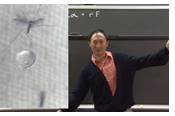
 The most recent addition to the BLOSSOMS online lesson library is based on research done by Professor David Hu and his team at the Georgia Institute of Technology. In this lesson, “How Mosquitoes Can Fly in the Rain”, Professor Hu explains the phenomenon by helping students calculate the impact of raindrops on flying mosquitoes. Just how do mosquitoes do it? It turns out that these insects combine an extremely strong exoskeleton with a minuscule mass to minimize the force of each raindrop when it hits. The fact that they are so much lighter than the raindrops means that the drops lose very little momentum when they collide with the mosquitoes, which translates into very little force expelled onto the insect. To do this work, the researchers used a high-speed camera that captured 4000 frames per second (a typical video camera captures 24 frames per second). Students watching this lesson will gain experience using Newton's laws, gathering data from videos and graphs, and most importantly, understanding the utility of making approximations. Watch the lesson here and read more about the research here. The most recent addition to the BLOSSOMS online lesson library is based on research done by Professor David Hu and his team at the Georgia Institute of Technology. In this lesson, “How Mosquitoes Can Fly in the Rain”, Professor Hu explains the phenomenon by helping students calculate the impact of raindrops on flying mosquitoes. Just how do mosquitoes do it? It turns out that these insects combine an extremely strong exoskeleton with a minuscule mass to minimize the force of each raindrop when it hits. The fact that they are so much lighter than the raindrops means that the drops lose very little momentum when they collide with the mosquitoes, which translates into very little force expelled onto the insect. To do this work, the researchers used a high-speed camera that captured 4000 frames per second (a typical video camera captures 24 frames per second). Students watching this lesson will gain experience using Newton's laws, gathering data from videos and graphs, and most importantly, understanding the utility of making approximations. Watch the lesson here and read more about the research here.
 BLOSSOMS is pleased to announce that January 7, 2013 marks the start date of our newest international partnership, with Universiti Teknologi Malaysia (UTM) in Johor Bahru, Malaysia. This initial one-year effort is Phase I of a larger multi-year program. Among the objectives of the UTM partnership are: BLOSSOMS is pleased to announce that January 7, 2013 marks the start date of our newest international partnership, with Universiti Teknologi Malaysia (UTM) in Johor Bahru, Malaysia. This initial one-year effort is Phase I of a larger multi-year program. Among the objectives of the UTM partnership are:
- To facilitate transfer of knowledge to UTM academics, STEM teachers and staff with reference to the production of BLOSSOMS lessons; and
- To assist STEM teachers to teach STEM subjects using BLOSSOMS lessons that offer more engaging and interactive learning environments.
The stretch goal of the project is to design and create 20 UTM-produced new BLOSSOMS lessons. In January, the MIT team will train 100 Malaysian high school STEM teachers in the classroom use of BLOSSOMS. The teachers will pledge to use BLOSSOMS at least twice in their classrooms and to complete an evaluation form for each. The MIT team will also train UTM faculty and staff in a "train the trainers” exercise, so that these UTM professionals will be able to provide continued support, training and encouragement to participating high school STEM teachers.
 Eighteen BLOSSOMS lessons have been reviewed and accepted by iCPALMS and eleven more are awaiting reviews. iCPALMS is a National STEM Digital Library Pathway linking teachers across the nation to online tools for planning and implementing instruction. Based on adopted standards governing what students must learn, this new portal is aimed at connecting educators with thousands of existing resources for teaching math and science, making this a truly innovative system. Although the initiative has been developed at Florida State University's Florida Center for Research in Science, Technology, Engineering and Mathematics (FCR-STEM), accepted resources will be aligned not only with Florida teaching standards, but also with the Common Core State Standards already adopted by most states, including Florida. How it works is that once a team of reviewers and experts have gone through and accepted the submitted resources, they are then released to the public on the website. So a teacher can be assured that all resources are tested and reviewed prior to going "live". MIT BLOSSOMS is pleased to be an early partner with iCPALMS. Read more about the initiative here. Eighteen BLOSSOMS lessons have been reviewed and accepted by iCPALMS and eleven more are awaiting reviews. iCPALMS is a National STEM Digital Library Pathway linking teachers across the nation to online tools for planning and implementing instruction. Based on adopted standards governing what students must learn, this new portal is aimed at connecting educators with thousands of existing resources for teaching math and science, making this a truly innovative system. Although the initiative has been developed at Florida State University's Florida Center for Research in Science, Technology, Engineering and Mathematics (FCR-STEM), accepted resources will be aligned not only with Florida teaching standards, but also with the Common Core State Standards already adopted by most states, including Florida. How it works is that once a team of reviewers and experts have gone through and accepted the submitted resources, they are then released to the public on the website. So a teacher can be assured that all resources are tested and reviewed prior to going "live". MIT BLOSSOMS is pleased to be an early partner with iCPALMS. Read more about the initiative here.
 |
|